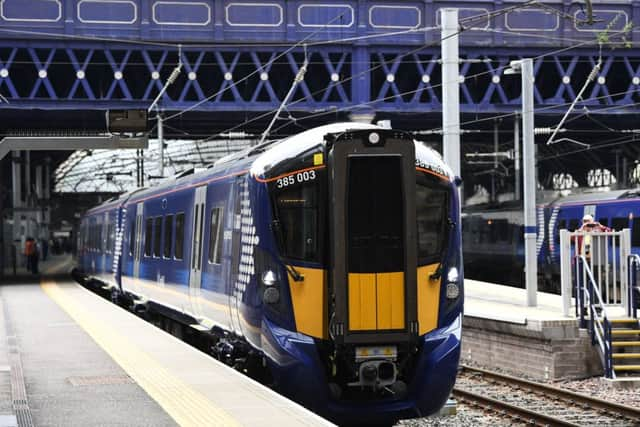Alastair Dalton: Roadtesting ScotRail's new train reveals many changes


The first of the Japanese-designed Hitachi fleet finally went into service on Tuesday on the main Edinburgh-Glasgow line, doubtless to the huge relief of the train operator, which has had to wait an extra ten months for the occasion.
The electric class 385 trains will become the backbone of the ScotRail fleet, replacing diesel class 170s that are nearly 20 years old, and eventually run on eight other Central Belt routes.
Advertisement
Hide AdAdvertisement
Hide AdHowever, only two of the 70 trains are ready, which are running as a single seven-coach set.


Few passengers will have experienced the newcomer yet because it is operating just one in eight services in each direction on the Waverley to Queen Street line.
It is quieter but it is possible the most bleary eyed and inattentive commuter won’t spot the changes on board, with similar external livery, internal layouts and seat covers to its predecessors.
However, most will immediately notice the far brighter interior – the old trains look positively dingy by comparison – bigger tables and taller seats. Even the fold-down tables on the airline-style seats are much bigger, although they may not wear so well, being white rather than grey.
The vestibules inside the doors are also slightly bigger, although if you’re looking for the extra fold-down seats, they’re now beside the toilets.
The other seats are thinner and firmer but seem as comfortable – though opinions may vary.
There are some definite improvements with the toilets, a key factor for many travellers.
For those never sure if they have locked the door, an announcement in the larger of two types of loo reminds you if you’ve forgotten, then confirms the door is locked.
Advertisement
Hide AdAdvertisement
Hide AdThe basin, with its natty swimming pool-effect colour scheme, is much bigger, with a handy airline-style, horizontal-lidded bin beside it and a separate one for sanitary waste.
Disappointingly though, the hand dryer is even more feeble than on the old trains in an age when we expect them to dry our hands in seconds, and those on some trains manage it.
Other improvements include better cycle space, clearly marked with a yellow bike symbol on the floor and signs giving them priority over luggage etc. There’s also a space in the adjacent carriage on the current services.
Coat hooks have been added to the side of seats, which each also have easy-to-grab yellow handles along the gangway to help steady yourself against sudden lurches while moving around the train. I also like the new “We’ll soon arrive at...” announcements, which have a more human and less robotic sound than previous recordings.
On the minus side, some strange design decisions include bins having far smaller openings to squeeze rubbish into, and the power sockets are difficult to find under the seats, with no explanatory signs visible in half the train.
Priority seats for disabled, elderly and pregnant passengers have a colourful and distinctive design to mark them out, but most have no window for passengers to see where they are.
The doors between the two trains coupled together have only a single see-through panel, so passengers looking for seats might think they have reached the end of the train.
The long gangway between them is also too narrow for two people to be able to get past each other. However, and here’s a tip if you’re suffering in the heat, it’s the coolest part of the train.
